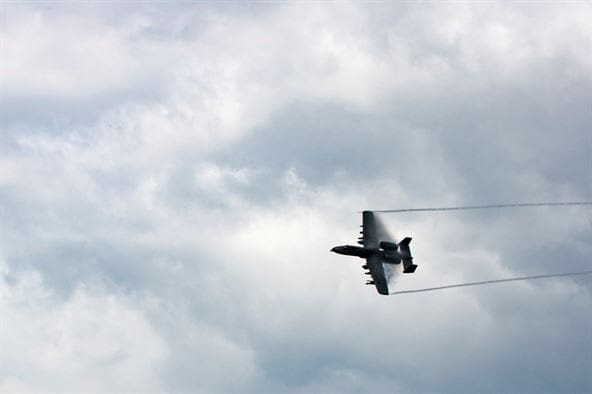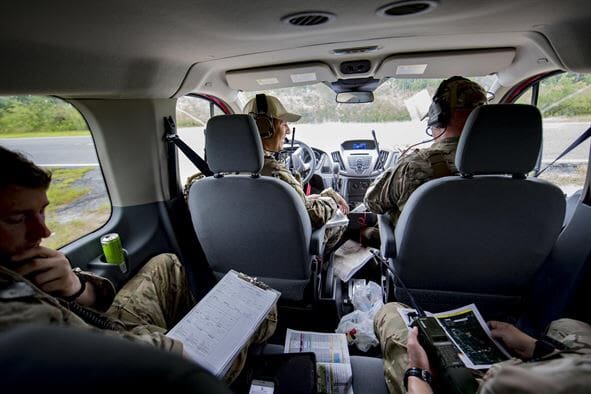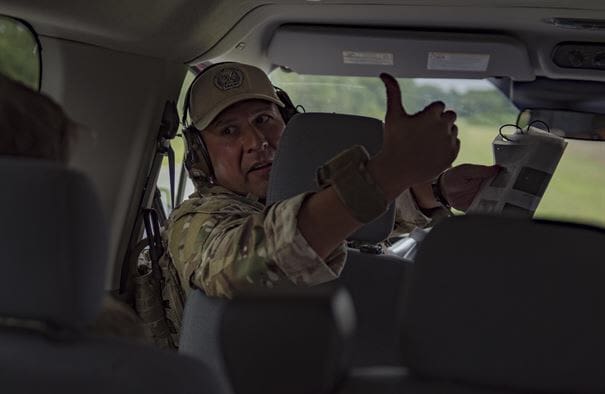MOODY AIR FORCE BASE, Ga. – Members of England’s Royal Air Force recently spent time immersed with the 93rd Air Ground Operations Wing at Moody Air Force Base, Georgia.

An A-10C Thunderbolt II conducts a show of force maneuver during training, July 26, 2017, at Grand Bay Bombing and Gunnery Range, Ga. The range features a moving target system, which is on a 1,000 foot long track that is remotely controlled by the control tower and can move back and forth to assist in training. (U.S. Air Force photo/Andrea Jenkins)
The NATO allies visiting were Joint Terminal Attack Controllers tasked with building stronger ties with the 93rd AGOW in hopes of future integration opportunities.
“All the missions overseas aren’t integrating just the U.S. Armed Forces, but also our NATO forces,” said Master Sgt. Francisco Corona, the 93rd AGOW NCO in-charge of weapons and tactics. “So all the NATO forces are trying to train with us. I’d rather integrate in (training) where we can make mistakes and learn from them instead of making mistakes in a deployed location.”
Since 2001, U.S. and foreign JTACs have been in high demand as liaisons between Army ground commanders and Air Force assets.

U.S. Air Force and Royal Air Force joint terminal attack controllers communicate with 23rd Fighter Group A-10C Thunderbolt IIs during a close air support training exercise, July 26, 2017, in Lakeland, Ga. Two Royal Air Force members recently spent time with the 93rd Air Ground Operations Wing to compare and contrast how each entity conducts business and to plan future coalition training events. (U.S. Air Force photo/Airman 1st Class Daniel Snider)
“As air-to-ground experts, we advise, assist and control for the ground commander to meet his intent, whether its kinetic effects, like bombs on targets, or getting smarter at cyberspace,” said Corona.
Both groups of JTACs said they’re no stranger to operating in coalition settings while deployed.
“While I was a JTAC in Afghanistan, the vast majority of our aircraft were U.S. aircraft,” said Squadron Leader Neil Beeston, the officer commanding Air Land Integration Cell. “It was great working with the U.S. Armed Forces, especially with the A-10s; it’s a fantastic aircraft. The troops on the ground know that when you’ve got a pair of them above you, you’re in pretty safe hands.”
While the JTACs and U.S. aircraft are skilled professionals, sometimes communication barriers exists between countries. Beeston’s colleague stressed the importance of hashing out common issues.
“The whole worldwide JTAC community has the same struggles,” said Flight Sergeant Simon Ballard, the chief instructor from the ALIC. “Since we’re going to be working together, we need to practice together before we go do that in the real world.”
Not having the allied JTAC community in sync and on par with each other could potentially lead to less-than-optimal situations, which in turn risks lives.
“We don’t want to learn how to work together in a war area of operations,” said Corona. “We’re flexible though, whether it’s [English] JTACs or whatever joint force JTACs, we make things happen and we’ll make it work.”

MSgt Francisco Corona, the 93rd Air Ground Operations Wing NCO in charge of weapons and tactics, communicates with a fellow Joint Terminal Attack Controller during a close air support training exercise, July 26, 2017, in Lakeland, Ga. Two Royal Air Force members recently spent time immersing with the 93rd Air Ground Operations Wing to compare and contrast how each entity conducts business and plan future coalition training events. (U.S. Air Force photo/Airman 1st Class Daniel Snider)
After the gathering, troops returned to their leadership with proposals and plans to further integrate training scenarios, whether it be academic courses or mixing into each country’s exercises to further synchronization.
“The bonus for them is they’d be integrating with different Army divisions because the 93rd AGOW is spread over at least six Army divisions,” said Corona. “They’d get that opportunity, where there’s not many divisions they work with over in [England].”
While Corona is confident in U.S. JTACs, he said it’s all about continuing to get better, to maintain leading from the front.
“We’re figuring out how we go to the next level to continue to be the best JTACs in the world,” said Corona. “We’re going forward with a proficiency mindset, of ‘how do we get better,’ because at the end of the day, the better trained individuals are going to be the winners.”
By Airman 1st Class Daniel Snider, 23rd Wing Public Affairs


The RAF belongs to all of Great Britain, not just England.
Well said!
Beat me to it.
We’re No JTACS from the British Army or Royal Marines involved? Seems like a wasted opportunity…
British Army JTACS and FAC have been training with the US airforce in the States and the UK for years this is the RAF regt JTACS